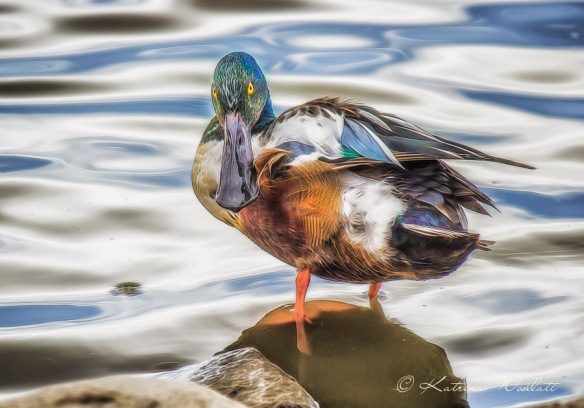This week I haven’t processed any images that have inspired me enough to post. But feeling a need to post something today, I selected this image of a Northern Shoveler (Anas clypeata) that was hanging out with a flock of mallards near shore in the bird sanctuary. Generally very shy, I was surprised that this drake allowed me to approach so close to him while he was primping, but he finally turned and looked at me with apparent exasperation, so I quickly captured this image and gave him a little more space.
At a casual glance, shovelers can easily be mistaken for mallards but can be distinguished from them by the large blue patch they display on their shoulder and their iridescent green speculum (a lustrous colored patch on the wing) as opposed to the absence of a shoulder patch and violet blue speculum of the mallard
This bird favors broad, shallow marshes where it can use the comb-like teeth along the edges of its large bill to strain aquatic animals, plants, and seeds from the water. They tend to forage on water bodies that provide seed from various plants including pondweed, bulrush, various grasses, sedges and algae. The remainder of its diet consists of mollusks, aquatic insects and zooplankton.
The unique bill morphology of Northern Shovelers allows this species to exhibit one of the most unusual feeding behaviors of any duck. Its large spoon shaped bill is adapted for sifting large amounts of muddy water. Their tongues are highly specialized with extensive comb-like teeth called lamellae, which help filter food items from the water. Moving its head side to side, water is drawn in at the tip of the bill, filtered through the lamellae to pick up any food particulate and then expelled at the base.
Socially, these dabbling ducks occasionally work together in groups while feeding, rotating like a ‘pin-wheel’, stirring up the surface water and skimming it for food particles. They also dabble through muddy bottoms in shallow ponds and will occasionally dive and feed underwater in deeper water bodies
During the breeding season, Northern Shovelers are widely distributed throughout central and western North America, Europe and Northern Asia. In the fall, Northern Shovelers migrate to the southern regions of North America, South America, North Africa and Southern Asia to over winter. Freshwater and saline marshes, industrial cooling ponds, agricultural wastewater ponds, coastal lagoons, estuaries and mangrove swamps provide wintering habitat.
Text drawn from http://www.borealbirds.org


What a handsome bird. And such a great pic too! 🙂
LikeLiked by 1 person
Thanks, Julie. I’m always fascinated by those enormous bills they sport.
LikeLiked by 1 person
Love the colours of this bird, are they for real?
LikeLike
Pretty much, altho his face was in shadow and I think I over-lightened his forehead, which tends usually to be dark, while the rest of the head is a gorgeous vibrant green just like a mallard drake.
LikeLike
Very interesting, informative post and beautiful capture, Katrina.
LikeLike
Thanks, Chris.
LikeLike
Great sharp image! Love the look of the water.
LikeLike
Thank you, Denise. 🙂
LikeLike
excellent colors and capture
LikeLike
Thank you!
LikeLike
Beautiful composure.
LikeLike
Thanks, Shannon.
LikeLiked by 1 person
Beautiful!
LikeLike
Thank you, Pierre. I appreciate the comment!
LikeLike
and he is a beauty!!! Great image!
LikeLike
Thanks, Cybele. It was a treat for me to have the opportunity for a closer up shot of one of these guys.
LikeLike
Beautiful work, waterfowl are my favorite, this one is outstanding!!
LikeLike